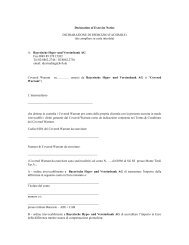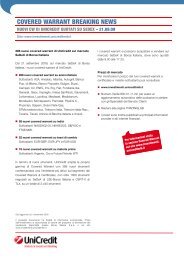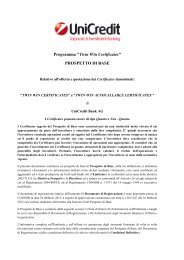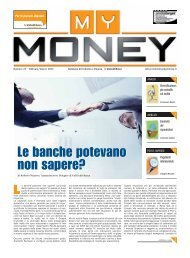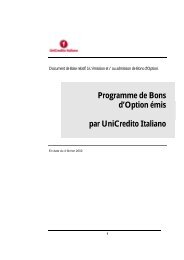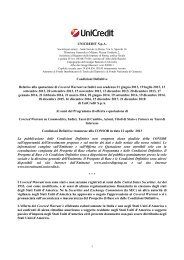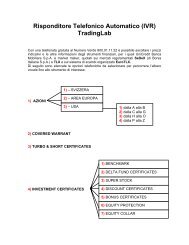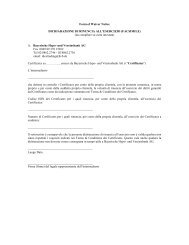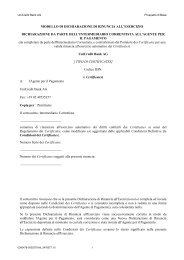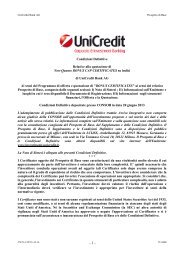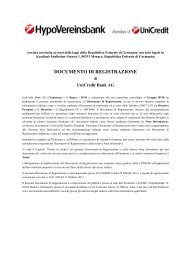UniCredit Bank AG
UniCredit Bank AG
UniCredit Bank AG
You also want an ePaper? Increase the reach of your titles
YUMPU automatically turns print PDFs into web optimized ePapers that Google loves.
Financial Statements (2) | Consolidated Financial Statements<br />
Accounting and Valuation (CONTINUED)<br />
6 Principles of consolidation<br />
Consolidation is performed by offsetting the purchase price of an affiliated company against the value of the interest held in the completely recalculated<br />
shareholders’ equity at the time of acquisition, provided the transactions involved are not internal to <strong>UniCredit</strong> Group. This amount represents the difference<br />
between the assets and liabilities of the acquired company, measured at the fair value at the time of initial consolidation. The difference between the<br />
higher acquisition cost and the prorated recalculated shareholders’ equity is recognised as goodwill under intangible assets in the balance sheet. Goodwill<br />
on companies accounted for using the equity method is carried under investments in associates, joint ventures and non-consolidated subsidiaries.<br />
Compliant with IAS 36, depreciation is not recognised on goodwill. The goodwill is allocated to the cash-generating units that are expected to benefit from<br />
the synergies arising from the business combination. At HVB Group, these cash-generating units are the divisions. Where the commercial activities of a<br />
company span more than one segment, the goodwill is distributed in line with the expected contribution to results at the time of acquisition. The goodwill<br />
is tested for impairment at least once a year at cash-generating unit level. This involves comparing the carrying amount of the CGU with the recoverable<br />
amount defined as the maximum of the unit’s value in use and the fair value less costs to sell. Since the value in use far exceeds the carrying amount for<br />
the CGUs to which goodwill is allocated, the values in use have been used as the recoverable amount. When the values in use are calculated, the divisional<br />
plans are employed as the basis and a uniform rate of 10.2% for the cost of capital is used for discounting. No growth factor has been assumed for the<br />
government perpetuity.<br />
IFRS 3 is not applicable to combinations of businesses under common control (IFRS 3.2c). IAS 8.10 requires an appropriate accounting and valuation<br />
method to be developed accordingly for such cases. Given that HVB Group is part of <strong>UniCredit</strong> Group, the carrying amounts of the parent company are<br />
retained for business combinations within the <strong>UniCredit</strong> Group. Any difference between the purchase price paid and the net carrying amount of the company<br />
acquired is recognised in equity under reserves.<br />
SIC 12 requires us to consolidate special purpose entities provided, in substance, the majority of the risks and rewards incident to the activities of these<br />
special purpose entities is attributable to us or, in substance, we control the special purpose entities. Where they are material, they are included in<br />
consolidation. An interest in the equity capital of the special purpose entities is immaterial in this regard.<br />
The assets and liabilities of the special purpose entity are included at the balance sheet date measured at their fair value when initially consolidated in<br />
accordance with SIC 12. They are subsequently measured in accordance with the uniform principles of accounting and valuation used across the corporate<br />
group. The expenses and income of the special purpose entity in question have been included in the consolidated income statement from the date<br />
of initial consolidation. Thus, the consolidation of special purpose entities in accordance with SIC 12 has the same effect as full consolidation. Equity<br />
interests held by third parties in a special purpose entity consolidated by us in accordance with SIC 12 are recognised under minority interest.<br />
The same principles are applied when consolidating associated companies and joint ventures accounted for using the equity method.<br />
Business transactions between consolidated companies are eliminated. Any profits or losses arising from intercompany transactions are also eliminated.<br />
7 Financial instruments<br />
A financial instrument is any contract that gives rise to both a financial asset of one company and a financial liability or equity instrument of another<br />
company.<br />
The classes required by IFRS 7.6 are defined as follows:<br />
– Cash and cash reserves<br />
– Financial assets and liabilities held for trading<br />
– Financial assets at fair value through profit or loss<br />
– Available-for-sale financial assets (measured at cost)<br />
– Available-for-sale financial assets (measured at fair value)<br />
– Held-to-maturity investments<br />
– Loans and receivables with banks (classified as loans and receivables)<br />
– Loans and receivables with customers (classified as loans and receivables)<br />
– Hedging derivatives<br />
– Other liabilities (deposits from customers, deposits from banks, debt securities in issue)<br />
– Liabilities from outstanding fund shares (for 2008 only)<br />
– Financial guarantees and irrevocable lending commitments<br />
F-13<br />
100 2009 Annual Report · HypoVereinsbank




